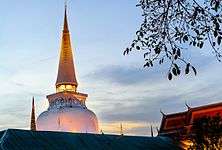Wat
.jpg)

A wat (Thai: วัด, pronounced [wát]; Lao: ວັດ vad; Khmer: វត្ត wōat) is a Buddhist temple in Thailand, Cambodia or Laos. The term is borrowed from Pali vatta, "which goes on or is customary, i. e. duty, service, custom, function".[1]
Introduction
.jpg)
Strictly speaking a wat is a Buddhist sacred precinct with a vihara (quarters for bhikkhus), a temple, an edifice housing a large image of Buddha and a structure for lessons. A site without a minimum of three resident bhikkhus cannot correctly be described as a wat although the term is frequently used more loosely, even for ruins of ancient temples. As a transitive or intransitive verb, wat means to measure, to take measurements; compare templum, from which temple derives, having the same root as template.
In everyday language in Thailand, a wat is any place of worship except a mosque (Thai สุเหร่า surao or มัสยิด masayit) or a synagogue (Thai สุเหร่ายิว - surao yiw). Thus a wat chin (วัดจีน) or san chao (ศาลเจ้า) is a Chinese temple (either Buddhist or Taoist), wat khaek (วัดแขก) or Thewasathan (เทวสถาน) is a Hindu temple and bot khrit (โบสถ์คริสต์) or wat farang (วัดฝรั่ง) is a Christian church, though Thai โบสถ์ (โบสถ์ bot) may be used descriptively as with mosques.
In Cambodia, a wat is used to refer to all kinds of places of worship. Technically, wat generally refers to a Buddhist place of worship, but the technical term is វត្តពុទ្ធសាសនា wat putthasasana. A Christian church can be referred as វិហារយេស៊ូ vihear Yesaou or "Jesus vihear". Angkor Wat អង្គរវត្ត means "city of temples".
Types
According to Thai law, Thai Buddhist temples are of two types:
- Wat (วัด; wat) are temples which have been endorsed by the state and have been granted wisungkhamasima (วิสุงคามสีมา), or the land for establishing central hall, by the king. These temples are divided into:[2]
- Royal temples (พระอารามหลวง; phra aram luang), established or patronised by the king or his family members.
- Private temples (วัดราษฎร์; wat rat), established by private citizens. Despite the term "private", private temples are opened to the public and are sites of public religious activities also.
- Samnak song (สำนักสงฆ์; samnak song) are temples without state endorsement and wisungkhamasima.
Structure

A typical Buddhist wat consists of the following buildings:
- chaidei (Khmer: ចេតិយ) or chedi (Thai: เจดีย์, Lao: ເຈດີ; from Sanskrit: chaitya, temple) or that (Lao: ທາດ) - usually conical or bell-shaped buildings, often containing relics of Buddha
- vihear (Khmer: វិហារ) or wihan (Thai: วิหาร, Lao: ວິຫານ; from Sanskrit: vihara) - a meeting and prayer room
- mondop (Thai: มณฑป; from Sanskrit: Mandapa) - a usually open, square building with four arches and a pyramidal roof, used to worship religious texts or objects
- sala (Khmer: សាលា, Thai: ศาลา, Lao: ສາລາ; from Sanskrit: Shala - School, from an earlier meaning of shelter) - a pavilion for relaxation or miscellaneous activities
- bot (Thai: โบสถ์) or ubosot (อุโบสถ; from Pali uposatha) or sim (Lao: ສິມ) - the holiest prayer room, also called the "ordination hall" as it is where new monks take their vows. Architecturally it is similar to the vihara; the main differences are the eight cornerstones placed around the bot to ward off evil. The bot is usually more decorated than the wihan.
- Ho trai (Thai: หอไตร, Lao: ຫໍໄຕ) - library where Buddhist texts are kept
- drum tower (Thai: หอกลอง, Lao: ຫໍກອງ)
- bell tower (Thai: หอระฆัง, Lao: ຫໍລະຄັງ)
- multipurpose hall (Thai: ศาลาการเปรียญ, study hall) is a building in a wat. In the past this hall was only for monks to study in.
The living quarters of the monks, including the kut, kutti, kuti or Kati (Thai: กุฏิ, Lao: ກຸຕິ, ກະຕິ; monk cells) are separated from the sacred buildings.
The roofs of Thai temples are often adorned with chofas.
Examples
| Look up wat in Wiktionary, the free dictionary. |
Some well-known wats include:
Cambodia
- Angkor Wat, Siem Reap
- Wat Preah Keo, Phnom Penh
- Wat Botum Vathey, Phnom Penh
- Wat Moha Montrey, Phnom Penh
- Wat Ounalaom, Phnom Penh
- Wat Phnom, Phnom Penh
- Wat Bakan, Pursat
Laos
Thailand
- Bangkok
- Wat Suthat, Bangkok, Thailand
- Wat Benchamabophit (The Marble Temple)
- Wat Ratchanatdaram
- Wat Phra Kaew
- Wat Arun
- Wat Bowonniwet Vihara
- Wat Pho
- Wat Saket
- Lan Na (Northern Thailand)
- Wat Phra That Doi Suthep, Chiang Mai
- Wat Chiang Man, Chiang Mai
- Wat Chedi Luang, Chiang Mai
- Wat Phra Singh, Chiang Mai
- Wat Phra That Lampang Luang, Lampang
- Wat Phumin, Nan, Thailand
- Other regions
Malaysia
Gallery
 Angkor Wat, Siem Reap, Cambodia
Angkor Wat, Siem Reap, Cambodia Wat Peapat, Battambang, Cambodia
Wat Peapat, Battambang, Cambodia Wat Phnom, Phnom Penh, Cambodia
Wat Phnom, Phnom Penh, Cambodia Two wihans and a chedi at Wat Phra That Chang Kham, Nan, Thailand
Two wihans and a chedi at Wat Phra That Chang Kham, Nan, Thailand Chedi and wihan at Wat Suan Tan, Nan, Thailand
Chedi and wihan at Wat Suan Tan, Nan, Thailand- Wat Phra Kaew, Bangkok, Thailand
 Wat Phrathat Doi Suthep, Chiang Mai, Thailand
Wat Phrathat Doi Suthep, Chiang Mai, Thailand- Wat Xieng Thong, Luang Prabang, Laos
See also
- Pura, Balinese temples
- Candi, temples of ancient Indonesia, especially Java
- Kyaung, Burmese monastery
References
- ↑ http://dsalsrv02.uchicago.edu/cgi-bin/philologic/getobject.pl?c.3:1:993.pali.753563 The Pali Text Society's Pali-English dictionary
- ↑ ราชกิจจานุเบกษา, ประกาศกระทรวงธรรมการ แผนกกรมสังฆการี เรื่อง จัดระเบียบพระอารามหลวง, เล่ม ๓๒, ตอน ๐ ก, ๓ ตุลาคม พ.ศ.๒๔๕๘, หน้า ๒๘๔